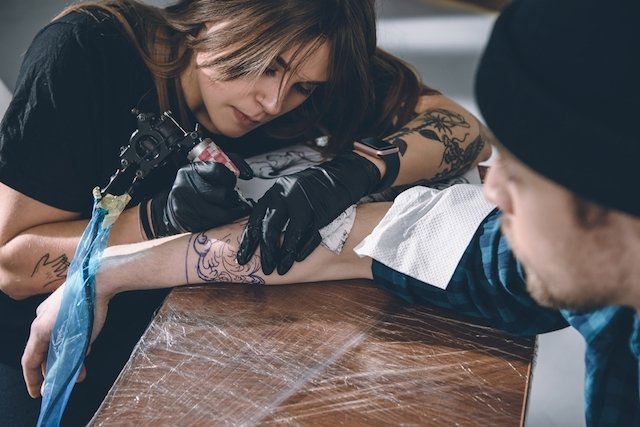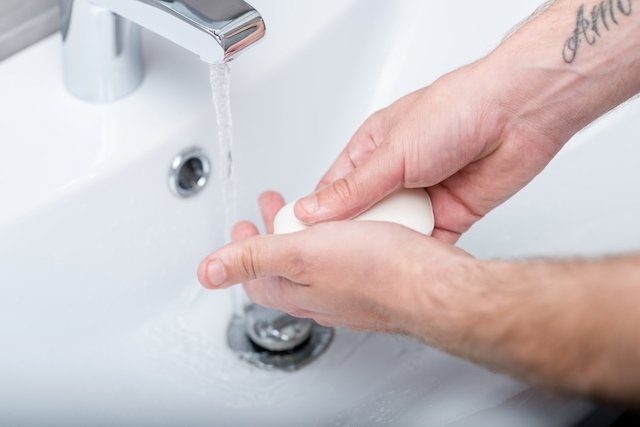After getting a tattoo, proper skin care is important for healing and for preventing infection. Adequate aftercare will also ensure your tattoo will remain well-defined and that its colors will continue to be vibrant for many years.
Tattoo aftercare should start as soon as you leave the tattoo parlor and it should be a life-long commitment.
See the tips below on how to take care of your new tattoo.

What to do on the first day
After getting your tattoo, your skin will be very sore and freshly wounded. There will an increased risk for skin infection during this time, as bacteria and viruses can easily enter the body through the wound. Therefore, it is important to wrap the tattoo with a bandage or cellophane for at least 4 hours after getting it (although this time can vary according to the type of tattoo you got). Be sure to follow your tattoo artist's instructions.
The bandage or cellophane wrap should be removed to avoid the accumulation of heat and moisture in the area, as these types of conditions will promote bacterial growth. Once the wrap is removed, it is important to wash the tattooed skin and to apply a moisturizer to stimulate skin healing.
What to avoid doing during the first days
There are some things you can do to reduce your risk of a skin infection, but these are especially important to do in the first 4 weeks to ensure adequate healing of your tattoo. These include:
- Do not pick at any scabbing that may be present in the first 4 days, as these scabs are still attached to the deeper layers of the skin where the ink is still trying to deposit itself
- Do not scratch your tattoo, even if it is itchy, as this may worsen any skin irritation and increase the probability of a skin infection (due to bacteria you may have under the nails)
- Do not soak your tattoo in water, especially in public areas like pools or beaches, as this may put you at increased risk for infection
- Avoid direct sunlight, as UV rays can cause skin inflammation and disrupt healing and colorization.
- Do not apply excessive amounts of creams, especially creams with petroleum (e.g. vaseline) as these will prevent the skin from airing out and healing properly
- Avoid eating foods that may interrupt healing, like pork, fried food and dry, cured meat.
- Avoid wearing tight clothing, as this will prevent the skin from airing out and can pull at the scabs that help with healing
In addition, it is important to be careful when returning to physical activity, as sweat can also dislodge ink that has not reached the deeper skin layers. Exercise completed in dirty places can also increase risk for infection, therefore you should avoid going to the gym or doing any exercise overall for at least 1 week.
How to wash your tattoo
Washing your tattoo for the first time is very important for guaranteeing adequate healing and for preventing an infection. This wash will help to remove any dry blood that has remained as well as dead skin cells. Before washing your tattoo, wash your hands thoroughly to remove any possible bacteria.
Put your tattoo under running water and lightly rub the area with your fingers. Avoid using a sponge or a washcloth. Then lightly rub an antibacterial soap over the skin. Ideally, the water should be just warm, without any steam (as heat can open skin poors, which allows bacteria to enter and ink to displace inside the skin).
Finish off by drying the skin well, by patting the tattoo with paper towel or allowing it to air dry. Avoid using bath towels, as they can contain high numbers of bacteria and can be rough on the skin.

How to reduce redness and swelling
Skin redness and swelling are very common in the first few days after getting your tattoo. These symptoms are a result of trauma caused by the tattoo gun, and they are also a natural part of healing. Therefore, mild redness or swelling should not be a major sign of concern.
The best way to quickly reduce these symptoms is by ensuring the skin is clean and dry. You should also apply a moisturizing cream that is gentle and unscented.
How to alleviate itching
After about 1 week, it is normal to experience constant itching in the tattoo area. This is due to scabbing that leaves the skin dry. To help relieve itching, you can apply a good moisturizer when you experience itching from very dry skin, like Nivea.
Lifelong aftercare
A tattoo will generally be fully healed after a month or two, but there are some skincare habits that you should continue to maintain on a lifelong basis. This will ensure that your tattoo will continue to be well-defined and that any coloring will last for longer. Some important skincare tips include:
- Apply a moisturizer on the tattoo daily
- Apply sunscreen over the tattoo if it will be exposed to the sun
- Avoid any cuts or blows to the tattoo
- Drink around 2L (or 8 cups) of water per day
In addition, maintaining a healthy lifestyle and consuming a balanced diet will also promote skin health, which will help to maintain the tattoo's appearance and longevity. Learn more about the foods you should eat and avoid when you get a tattoo.
When to go to the hospital
In most cases, the tattoo will heal easily without any major complications. However, you should go to the hospital if any of the following symptoms emerge:
- Skin that becomes intensely red
- Bleeding tattoo
- Swelling in the tattoo area
- Intense pain at the tattoo site
In addition, you should look out for other symptoms that could indicate an infection like fever over 38ºC (or 100.4ºF) or feeling tired. If these symptoms appear, you should see your doctor.
